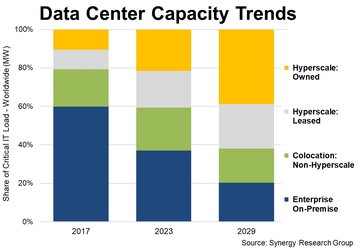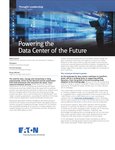Hyperscalers now account for 41 percent of worldwide data center capacity, according to data from Synergy Research Group.
Comparatively, non-hyperscaler colocation capacity accounts for another 22 percent, while on-premise data centers make up the remaining 37 percent.
Just six years ago, 60 percent of data center capacity was on-premise.
Synergy predicts that this change will only accelerate, with hyperscalers expected to account for more than 60 percent of capacity by 2029 and on-premise dropping to just 20 percent.
This is framed within expected capacity overall to drastically increase - with hyperscale capacity expected to grow threefold over six years. Colocation capacity will continue to increase, though its percentage share is expected to slowly decrease. On-premise capacity is expected to remain stable.
According to Synergy chief analyst John Dinsdale, data center capacity varies region by region.
"Hyperscale-owned data center capacity is much more prevalent in the US than in either Europe or the APAC region. However, overall the trends are all heading in the same direction - and it is easy to see what is behind these trends," Dinsdale said.
He puts this growth down to a shift in enterprise spend, from 2012 with enterprises spending twelve times as much on their data center hardware and software as they did on cloud infrastructure services
"Today they spend three times more on cloud services than they do on their own data center infrastructure,” said Dinsdale.
He added: "Enterprises are also choosing to house an ever-growing proportion of their data center gear in colocation facilities, further reducing the need for on-premise data center capacity. The rise of generative AI technology and services will only exacerbate those trends over the next few years, as hyperscale operators are better positioned to run AI operations than most enterprises.”
Another Synergy study found that enterprise spending on cloud computing reached $79 billion in Q2 of 2024.




